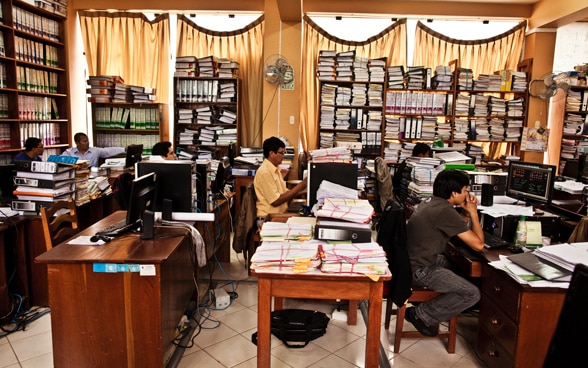
Growth in Peru – also thanks to reforms of public finances

To reduce poverty, Switzerland focuses on sustainable economic growth in its international cooperation. As the example of Peru shows, solid and well-managed public finances are just as much a part of this as a growth-friendly environment.
Peru has recorded impressive economic growth for a number of years, largely driven by an increase in commodities trading. At the same time, the country is steadily developing a system to manage government finances efficiently and transparently, and is doing so with remarkable success. These factors have led to a significant improvement in Peru’s financial scope for action. This benefits the population in remote areas, for example through the construction of new schools and health centres, investment in sewage facilities and waste disposal, and in the construction and maintenance of roads. Peru has therefore evolved from a developing country to a vibrant emerging market in the space of a few years. It is currently one of few countries in Latin America that regularly runs a state budget surplus.
How well are finances managed?
Experts agree that well-managed public finances are one of the key factors in the positive development of a country: revenue and spending policy should be sustainably structured; debt should be carefully managed; public procurement, accounting and reporting should be transparently disclosed and internal and external audits should be reliably organised.
SECO started supporting Peru on this long journey around ten years ago. At the time, the country launched a review of its public finance management and implemented the Public Expenditure and Financial Accountability (PEFA) analysis tool, which was co-designed by SECO. PEFA gauges the quality of public finance management and identifies weaknesses: how plausible and transparent is the state budget? Are the annual estimates based on clear political objectives? Is government spending carefully planned and controlled?
Improving public financial management. Supporting sustainable development, PEFA
Sustainable reform programme delivers services for all
In 2011, Peru embarked on an extensive reform programme. Switzerland, the EU, the World Bank and the Inter-American Development Bank supported the initiative. The reforms aim to improve the fiscal discipline of the economy and the population, to make strategic use of available resources and to deliver government services that take better account of the actual needs of citizens and their businesses. As a result, the government is to be more accountable to the population: all government spending should be traceable at all times which should make government financial resources more predictable. This reinforces citizens’ trust in their government – and their willingness to pay taxes.
From the centre to regions and local authorities
In parallel to the reforms of central government, SECO also supports projects in various parts of Peru. Besides the ministries in the capital, the state financial budget also includes 26 regional governments and 1,834 local authorities. Involving all these actors in a reform programme is a huge challenge.
Ultimately the project is about ensuring sound public finances to fund effective public services: even in remote areas, children and breastfeeding mothers should be able to consult a doctor quickly and easily, and even in villages a long way from the capital, schoolchildren should not have to repeat their school year just because there are not enough teachers or classrooms.
Reforms not yet complete
In June 2016 Peruvians elected a new president, Pedro Pablo Kuczynski. His government intends to further boost investment in infrastructure and to advance Peru into the ranks of the world’s 50 most competitive countries. The SECO programme is still running, but it is important to build the trust of the new government to ensure the programme’s continuity. This will require a great deal of time and dialogue.
Thanks to the support of Switzerland and other donor organisations, Peru has professionalised its fiscal policy. The population is enjoying more and better services. However, the absolute connection between the reforms and the progress made is not in evidence everywhere. Many different factors play a role. And a quarter of Peru’s population of just under 30 million still lives in poverty. While sound public finances do not yet guarantee good public services, they are an important premise on which to provide and review such services. They are also a key factor in ensuring good economic framework conditions and governance. These ensure that countries like Peru are better able to tackle challenges, such as economic and financial crises and the consequences of climate change.
The programme in Peru is an example of how SECO promotes stable economic framework conditions that are central to sustainable growth in its partner countries. In addition to developing effective institutions and services, it supports measures that create more and better jobs and that strengthen trade, competitiveness and a low-emission economy.
